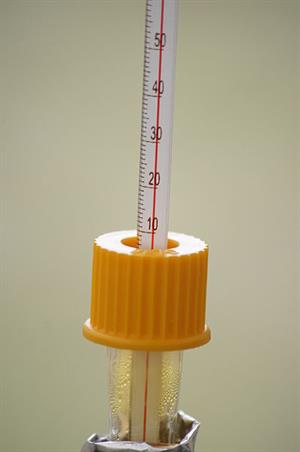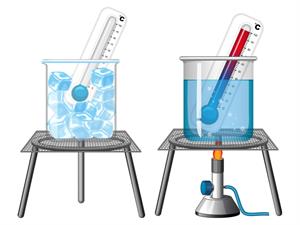PDF chapter test TRY NOW
In few scientific applications, it may required measuring the temperature higher than \(42\)°\(C\) and lesser than \(35\)°\(C\); in such cases clinical thermometers cannot be used. We need a laboratory thermometer in such cases.
Laboratory or Lab thermometers are the instruments that are used to measure the temperatures for scientific researches in schools and labs.

Fig. - Laboratory Thermometer
Lab thermometers are designed to measure the temperatures, the boiling point and the freezing point of substances.

Fig. - Experiment on Laboratory Thermometer
In industries, it is used to measure temperatures higher than what clinical thermometers can measure.
Structure of Laboratory Thermometer:
- It has a long narrow tube (Stem) and bulb compared to the clinical thermometer.
- There is no kink in the Laboratory thermometer.
Temperature Scale in Laboratory Thermometer:
- It has only the Celsius scale ranging from −\(10\)°\(C\) to \(110\)°\(C\).
Important!
Precautions to be followed while using a Laboratory Thermometer:
- Do not tilt the thermometer while measuring the temperature. Place it upright.
- Note the reading only when the substance from all sides has surrounded the bulb.
- Make sure that the bulb should not touch the bottom or sides of the container.
- Do not move the thermometer while doing the measurements.
Difference between Clinical and Laboratory Thermometers:
Parameter to be compared | Clinical Thermometer | Laboratory Thermometer |
| Application | Clinical | Scientific Research and Lab |
| Uses | It is used to measure the human body temperature. | It is used to find out the boiling point and freezing point of the substances |
| Range | \(35\)°\(C\) to \(42\)°\(C\) / \(94\)°\(F\) to \(108\)°\(F\) | \(10\)°\(C\) to \(110\)°\(C\) |
| Structure | Mercury level does not fall on its own, as there is a kink near the bulb to event the fall of mercury level. | Mercury level falls on its own as no kink is present. |
| Working | Temperature can be read after removing the thermometer from the armpit or mouth. | Temperature is read while keeping the thermometer in the source of temperature, e.g. a liquid or any other thing. |
| Restoration | Jerks are given to lower the mercury level. | No need to jerk to lower the mercury level. |
Reference:
Image credit:
https://commons.wikimedia.org/wiki/File:Lab_thermometer_2.JPG
